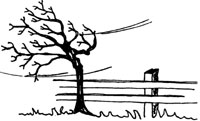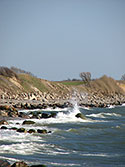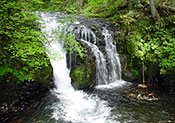| |
and there are more mental health problems and suicides. Physical health too seems to deteriorate with no real medical explanations. These winds resemble the atmosphere we have in cities, where there is a preponderance of positive ions.
If, however, we are by a waterfall or by the sea, where water droplets are being broken up, the ions are negative and in abundance. |
 |
 |
In the mountains or by large trees the ions are also negatively charged. The air is good to breathe and we feel a lift and a sense of calm relief. The tensions seem less and we are not so oppressed.
In cities though, negative ions are lost as they stick to air-conditioning ducts, fabrics, and walls. It is radiation from space and from sunshine, rocks and even from some soils that puts them back into our air.
When negative ions are in the air we breathe, the cilia are very active. These are microscopic hairlike parts that move with a whip-like action of 900 beats a minute. This is how the air is cleaned that gets into our lungs. When we breathe this negatively ionised air our endurance is increased, response to visual stimuli improves and it has been noted that healing takes place faster after |
|
surgery or burns and those with chest problems were considerably helped after negative ion therapy. Many claim to be able to sleep more deeply and for longer. Babies seem calmer and do not cry so often. In a negative ion environment we can all breathe more easily, concentrate better and the body cells are better benefited by the air we inhale.
Exercise in the fresh air is vitally important. |
 |
Exercise in a gym does not give you the same benefits. When we exercise in the fresh air and sunshine, and this can mean striding or a gentle walk, or even for those more disabled just sitting in these health giving environments and turning ankles and wrists or neck or any other parts that will move easily, we are gaining multiple benefits.
Mountain scenes will remind you of negative ions, pure fresh air, cool water, good ‘out of puff’ exercise, sunshine, wide optimistic horizons and a good healthy appetite.
Something to think about.
When we breathe we take in oxygen, but our bodies only hold onto a fifth part of it, the rest is exhaled. What if the air we breathe to start with has a very low amount of oxygen? We need oxygen for making new cells, fighting disease, for thinking. How many times a day do you breathe air outside a building? Today's people live in centrally heated homes, travel in vehicles with recycled air (to avoid pollution while keeping warm), |
 |
fly in planes with sealed oxygen systems breathing each others germs for hours at a time, go to work in office blocks and buildings that are sealed for security so that windows are never able to to be opened, visit or stay in hospitals or residential homes where people rarely see the outside world, take our leisure in pubs, restaurants, clubs, theatres, cinemas, or supermarket complexes. Some of these have no visible windows, others have all man made fabrics or recycled air. In the course of a normal day many hardly ever breathe negatively ionised real fresh air that has blown over oceans, fields and forests.
|
|
<< Back | Page 1 | More >>
[ Home ] [ About Us ] [ Using The Gifts Of Creation ] [ Contact Us ]
Copyright © 2008 healthandhope.org.uk |
